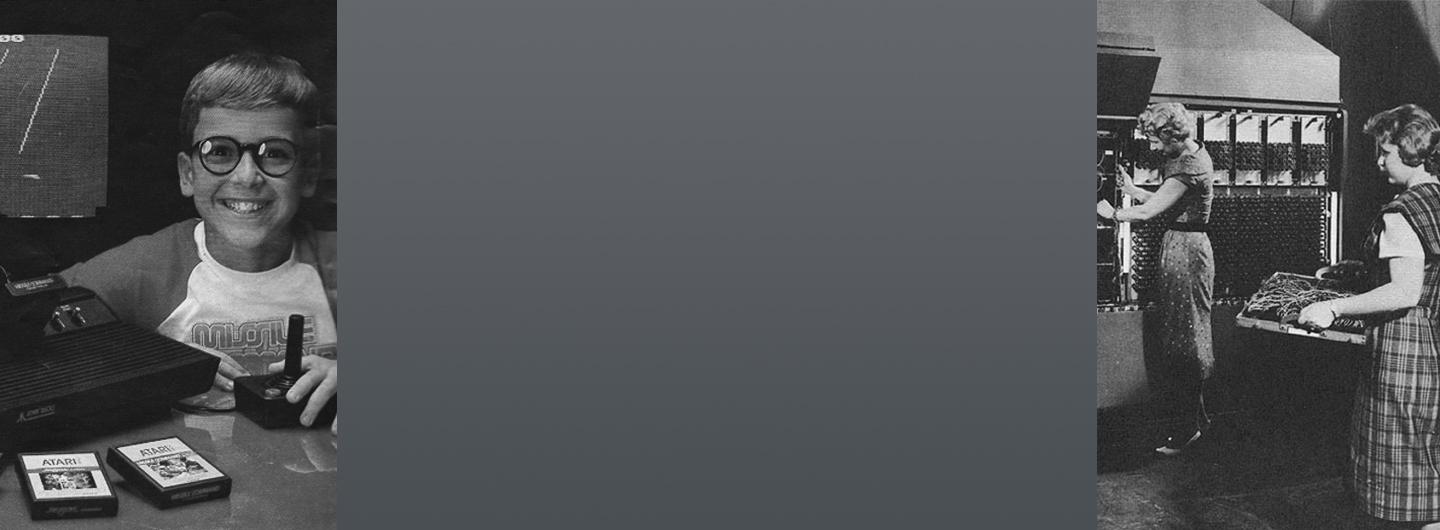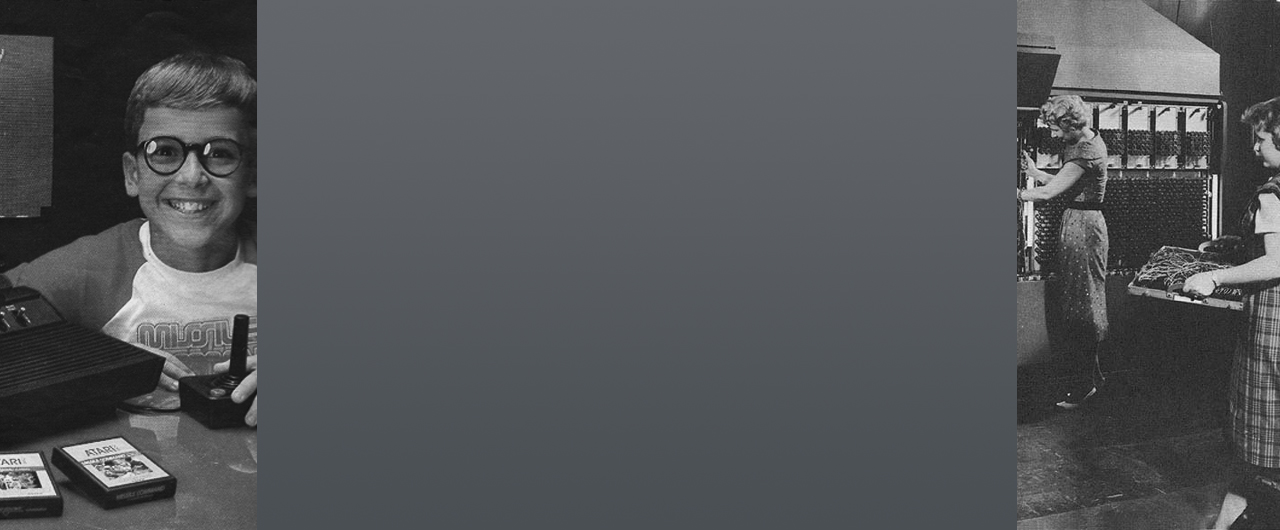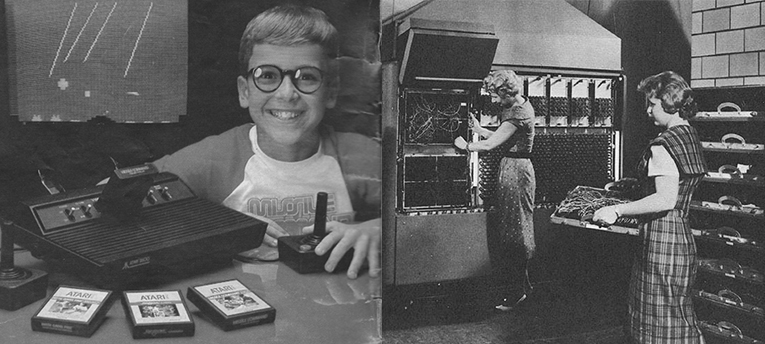





Storing information as electrical or electronic connections is similar to using holes: an electrical connection (in this context) is either present or not. An array of connections can store binary numbers—machine code, for example, as in the discrete component ROM below—or each connection can have a pre-established meaning that depends on the circuit it closes, like a plugboard. Electrical pathways can also be connected in less direct ways by transformers or capacitors (as in the IBM BCROS ROM below) and electronically using diodes or transistors.


Starting with Hollerith's use of punch cards in the 1890 census, punch card machines did more than simply read cards. Hollerith's first machine was a tabulator—it counted the number of times a hole appeared in a certain location on the card, which might correspond, for example, to gender or race. Later machines were able to add and subtract numbers stored on cards, then send the results to a printer or a more sophisticated machine for further processing.
Tabulators were originally hardwired. Hollerith introduced plugboards to simplify reprogramming in 1906. Connecting two holes in the panel with a wire completed a circuit that passed data from one component of the machine to another. Setting up a task could be complex and time consuming. Removable plugboards were introduced in the 1920s, again by Hollerith, to allow storing programs offline. A collection of stored programs would consist of racks of preprogrammed plugboards, which could be loaded into the machine for different tasks.
A succession of IBM machines used plugboards, including the highly successful IBM 407 Accounting Machine introduced in 1949 and in use into the 1970s. Plugboards were also used as control panels for certain computers in the 1950s and 1960s, including machines from IBM and UNIVAC (see the right-hand photo above).


Cipher machines, typically used by the military or intelligence services, scrambled messages to ciphertext and back. Some were mechanical; others, like the German Enigma machine or the Swiss NEMA, were electrical. These used a series of 3 to 10 rotors, each of which had electrical contacts on both sides connected internally by customizable wiring. The rotors were stacked side-by-side on an axel, with the contacts of one touching those of its neighbor, thus forming circuits through the entire set of rotors. The rotors were individually rotated by hand to set the "code". The rotor below from a Russian Fialka machine is of this type.


A number of devices were developed in the first half of the 20th century to teach Morse code. Each required a way of storing patterns of dots and dashes. Solutions included punched tape, notched disks and inked tape, with the contents read mechanically, electrically or optically. The example below uses a pattern of insulating material printed on an aluminum cylinder. The "message" is read by electrical contacts held against the cylinder as it rotates


IBM used several types of non-semiconductor-based ROM to store microcode for different models of the System/360. BCROS, or Balanced Capacitor Read-Only Storage (shown below), used a grid of capacitors etched in copper to store bits. An array of parallel copper strips overlaid a second, orthogonal array of strips, with a very thin gap between the two arrays. Where the vertical and horizontal strips crossed each other, larger tabs projecting from the strips created a capacitance that would transfer electrical energy when a voltage was applied to the vertical set of strips. That electrical coupling was a form of connection between the strips. A bit was represented by the crossings of two neighboring strips in both arrays, with the configuration of tabs determining whether it was a binary 1 or 0.


Mask ROM is an integrated circuit containing two orthogonal, overlapping arrays of conductors. In this, it is similar to BCROS (described above). The difference is that to represent a binary 1, conductors are connected where they cross by a diode or transistor. Unconnected crossings represent a 0. Mask ROM is manufactured using photolithography, in which a photomask is used in etching circuits. Once created, the program or data represented by the chip cannot be changed. Like any integrated circuit, mask ROMs can be soldered permanently into a device's circuit boards. However, to turn ROM into removable media, it is packaged in a pluggable cartridge. Unlike software on a tape, floppy or CD, the software on the ROM chip is run directly, without loading it into RAM, since it is mapped into the computer's address space.
It is difficult to know, in some cases, whether mask ROM or EPROM was used in a particular cartridge. I'm assuming mask ROM unless I've found specific information otherwise, but corrections would be greatly appreciated. Most game cartridges used mask ROM, since it was cheaper in the quantities typical for a consumer product, but manufacturers would occasionally use more expensive EPROM for cartridges manufactured in low quantities or to apply a patch to a previously released game. Cartridges that allowed users to save games contained EEPROM or flash memory in addition to the ROM used to store the game.
Software for the first video game consoles was built into the console itself. In 1976, the Fairchild Channel F introduced interchangeable cartridges, in which the game data and program were stored in a ROM chip packaged in a plastic cartridge that could be plugged into the console.
The first handheld game to use removable cartridges, the Mattel Microvision, appeared in 1979, but it wasn't until Nintendo released the Game Boy in 1989 that handhelds took off. Battery life was a challenge. Nintendo used a small, black and white, non-backlit display and a low powered processor. Other handhelds like the Sega Game Gear and Atari Lynx were more advanced, but were more expensive and suffered from shorter battery life and were not as successful.
Coin-operated amusements in arcades and other public spaces have a long history going back to the late 19th and early 20th century, including machines like mutoscopes, music boxes, player pianos and automata, and games like Skeeball and pinball. Video games made their first appearance in arcades in 1971. The first game, Computer Space, was a failure, but its creators then started a little company called Atari and released another game: Pong. It became a phenomenon and launched the video game industry. Dedicated Pong consoles for the home soon followed.
In 1980, Data East introduced the DECO Cassette System, which allowed owners to load new games from a standard tape cassette. It was not widely adopted, partly because cassette tapes were unreliable. In the mid-1980s, Nintendo introduced the VS. system and the Playchoice 10, which allowed games to be swapped by plugging in a different ROM chip or circuit board. The Neo Geo MVS from SNK Corp. was the first arcade platform to use an actual cartridge.
Libraries for popular game consoles often included some educational titles, but starting with Texas Instrument's Speak & Spell in 1978 consoles targeted specifically at education appeared. Companies like Vtech and LeapFrog that specialized in educational games and toys marketed consoles and tablets designed for educational games (and still do). The Speak & Spell became a cultural touchstone when it was included as a key plot element in Spielberg's E.T. the Extraterrestrial.
Some early personal computers and programmable calculators loaded software (other than games) from cartridges.
Fonts for computer printers are now typically downloaded from the computer, but until sometime in the 1990s, many printers could load fonts from cartridges plugged directly into the printer. ROM cartridges could hold bitmap fonts or vector fonts like TrueType and Postscript.
In the late 1990s, there were few good options for middle-schoolers who wanted portable music. The Walkman was long gone. CDs were expensive and portable players unreliable. The iPod hadn't arrived yet. For a few years, prerecorded music on tiny ROM chips made sense, at least for an age group that might be satisfied with a one minute excerpt. Hit Clips were extremely popular during that brief window.